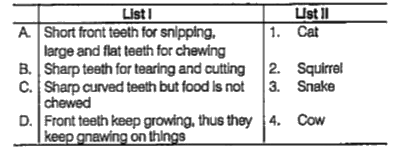What name is given to the following ?
An animal which is an exact copy of its parents.
Zygote
Embryo
Clone
None of the above
The correct Answer is:C
Step-by-Step Solution:
1. Understanding the Question: The question asks for the name of an animal that is an exact copy of its parent. This implies that the animal has identical genetic material to its parent.
2. Identifying Key Terms:
- Zygote: This is the initial cell formed when a sperm fertilizes an egg. It is not an exact copy of the parent but a combination of both parents' genetic material.
- Embryo: This is the developmental stage that follows the zygote. It is still not an exact copy of the parent.
- Clone: A clone is an organism that is genetically identical to its parent. This means it is an exact copy in terms of DNA and characteristics.
3. Analyzing the Options:
- Since a zygote and an embryo do not represent an exact copy of the parent, we can eliminate those options.
- The only option that fits the description of being an exact copy of its parent is "clone".
4. Conclusion: The correct answer to the question is "clone".
Final Answer: The name given to an animal which is an exact copy of its parent is clone.
---
- Zygote: This is the initial cell formed when a sperm fertilizes an egg. It is not an exact copy of the parent but a combination of both parents' genetic material.
- Embryo: This is the developmental stage that follows the zygote. It is still not an exact copy of the parent.
- Clone: A clone is an organism that is genetically identical to its parent. This means it is an exact copy in terms of DNA and characteristics.
- Since a zygote and an embryo do not represent an exact copy of the parent, we can eliminate those options.
- The only option that fits the description of being an exact copy of its parent is "clone".
Topper's Solved these Questions
Similar Questions
Knowledge Check
Identify the names of the following animals with their respective classes from the given options
 AA- Salamadra, Urochordata, B- Chelone Cephalochordata, C- Chameleon HemichordataBA- Salamandra Amphibia B- chelone Amphibia C-Chamleon, AmphibiaCA- Salamandra, Reptilla, B- Chelone Reptilia, C- Chameleon ReptiliaDA- Salamandra Amphibia, B- Chelone, Reptilla, C- Chameleon Reptilia
AA- Salamadra, Urochordata, B- Chelone Cephalochordata, C- Chameleon HemichordataBA- Salamandra Amphibia B- chelone Amphibia C-Chamleon, AmphibiaCA- Salamandra, Reptilla, B- Chelone Reptilia, C- Chameleon ReptiliaDA- Salamandra Amphibia, B- Chelone, Reptilla, C- Chameleon ReptiliaWhich among the following is not an exact differential?
AdqBdGCd¯¯¯VDdSWhich one of the following is an exact example of article radioactive?
A.2311Na+.10n→.2411Na+γ
.2411Na+.11H→.2412Mg+.10nB.42He+.147N→.178O+.11H
.178O+.10n→.187O+.11HC.42HE+.2713Al→.3015P+.10n
.3015P→.3014Si+.0−1eD.89238Ac→.22490Th+β
.22890Th→.22488Ra+α
Name the animals which lay eggs.
View SolutionThere are two lists given below. List I has characteristics of teeth of different animals and List II has name of animals.

Which one of the following options matched List I to List II correctly ?
View SolutionWhich one of the following animals is correctly matched with its particular named taxonomic category
View SolutionWhich one of the following animals is correctly matched with its particular named taxonomic category?
View SolutionWhich one of the following animals is correctly matched with its particular named taxonomic category
View Solution
